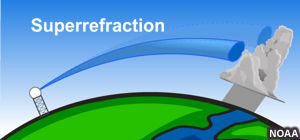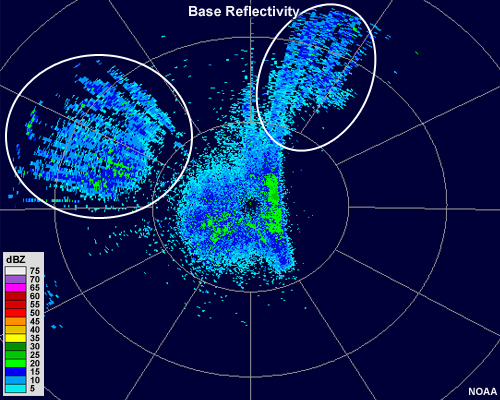Common Clear Air Phenomena » Non-Meteorological Returns » Anomalous Propagation

As we saw earlier, anomalous propagation (superrefraction) most commonly occurs when sharp inversions in the lower troposphere bend radar beams downward as they travel away from the radar. This phenomenon may cause a widespread cluttered appearance at the ground, or only certain features, such as local hilltops or buildings, may be intercepted. This image shows an example of anomalous propagation.

Here are a few key points to keep in mind about anomalous propagation echoes:
- When viewed as a time series, echoes will not change much over several frames. Some echoes may disappear or reappear, but will do so in mostly the same location.
- The targets' velocities in the suspected area will be at or nearly zero.
- Reflectivity values in areas of anomalous propagation are often erratic and do not resemble any usual precipitation patterns.
- Echoes may also be relatively weak and extend for great distances in a beamlike shape.
- Look at another nearby radar to help determine whether an echo is from precipitation.
- Look at recent satellite data to see if there are actually any clouds present.
- Look at the most recent local sounding to see if a sharp inversion is present.
- Look at a map of local topography to see if echoes are collocated with higher terrain.
Question
View the radar reflectivity and base velocity loops in the tabs below.
Now use the pen tool to outline any regions of anomalous propagation, then click Done.
| Tool: | Tool Size: | Color: |
|---|---|---|
|
|
The area of anomalous propagation is circled in red. Radar reflectivity returns change only slightly in intensity over the duration of the loop, they do not move, and they do not look like usual precipitation patterns. The echoes in this area also show up very clearly with radial velocities of zero in the base velocity loop. The long purple beams are range-folded and likely a result of ducting and/or ground interference.